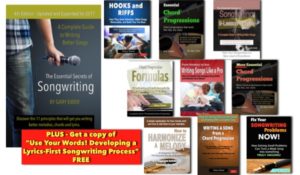Even non-musicians have an idea of what the hook of a song is: it’s the short, memorable bit that comes immediately to mind when you ask someone, “Hey, do you know the song ____?”
Back in the 70s, if you asked someone, “Hey, do you know the song “Stayin’ Alive”, they’d immediately sing, “Ah, ah, ah, ah, stayin’ alive, stayin’ alive.” That’s the main chorus hook.
 “Hooks and Riffs: How They Grab Attention, Make Songs Memorable, and Build Your Fan Base” shows you how songwriters in decades past have used many different kinds of lyrics to create great songs. Use it to create your own great song hooks.
“Hooks and Riffs: How They Grab Attention, Make Songs Memorable, and Build Your Fan Base” shows you how songwriters in decades past have used many different kinds of lyrics to create great songs. Use it to create your own great song hooks.
For songwriters, though, you need a more specific definition if you want to write a hook that really works. The most important aspects of a song hook are:
- An enticing melodic shape. Most hooks have a melodic shape that’s immediately noticeable and interesting.
- A catchy rhythm. Along with that melodic idea is a rhythmic aspect that partners up with the mood of the song.
- A strong chord progression. You may like complex chords, but most song hooks work best when they’re supported by basic, tonally strong chords.
We associate hooks with pop music, but the truth is that every genre features songs that use hooks, even classical music. (Beethoven’s 5th Symphony, Tchaikovsky’s 1812 Overture, and Handel’s Hallelujah Chorus, to name a few.)
Though it’s easy to define a hook, it’s not so easy to write music according to definitions. In other words, it won’t do you a lot of good to try to use those 3 defining qualities of hooks if you don’t have the makings of a hook in your mind already.
In most songwriting, improvising and experimenting to come up with a hook, and then examining your idea closely for how well it fulfills the basic definition of a good hook is a much better way to go.
One Possible Hook-Writing Process
Starting the songwriting process by coming up with a hook, therefore, is a good idea. It ensures that you’ve created something that, on its own, sounds catchy. You then work to add to your idea, and hopefully eventually come up with a complete song.
If you’d like to try starting your next song by working out the hook first, try these steps. It’s a kind of create-the-melody-first process:
- Hum some random note, around the middle of your vocal range. Keep this simple… maybe choose an E or a G.
- Try adding rhythms to that one note. This means getting a sense of tempo as well. Tap your foot to get that beat feeling solid, and now try improvising rhythms.
- Now start changing notes, making some higher, some lower. Always remember that repetition is an important part of good songwriting, so find a melodic pattern you like, and repeat it a few times.
- Add some guitar chords. Since your first melody note was an E or G (both notes in a C chord), try starting with a C chord, and let your imagination take you from there.
- Start adding lyric ideas. You’ll notice that the rhythm of your melody will start to sound like certain words which have a similar rhythmic pattern.
When doing this process, you’ll notice that sometimes you’ll come up with something quickly, within seconds, while at other times you’ll find the process won’t go anywhere for you and you have to start over.
Once you’ve got a hook that sounds usable, you can turn your attention to other parts of your song, such as the verse. And remember, you can always return to that hook and refine it and make it better.
There are other ways to start hooks, and they’re all outlined, step-by-step in “Hooks and Riffs: How They Grab Attention, Make Songs Memorable, and Build Your Fan Base.” That eBook is part of “The Essential Secrets of Songwriting 10-eBook” Bundle.
 Written by Gary Ewer. Follow Gary on Twitter.
Written by Gary Ewer. Follow Gary on Twitter.
 “The Essential Secrets of Songwriting” eBook bundle includes “Writing a Song From a Chord Progression”. Learn how to write great songs by starting with the chords, and then avoiding all the potential pitfalls of the chords-first songwriting process.
“The Essential Secrets of Songwriting” eBook bundle includes “Writing a Song From a Chord Progression”. Learn how to write great songs by starting with the chords, and then avoiding all the potential pitfalls of the chords-first songwriting process.










